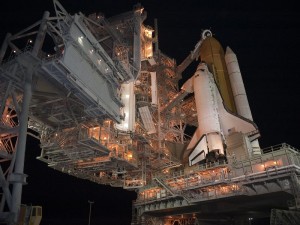What’s wrong with the process above?
This process provides instructions on how to remove the over-wing exit door on an airplane during an emergency. However, imagine performing this process in an actual emergency. During the time you spend opening the door, there will probably be people crowded behind you, frantic to get off the plane. Step 4 indicates that after the door is detached from the plane wall, you should turn around and set the door (which is about 4’ by 2’ and can weigh more than 50 pounds) on the seats behind you. In most cases, this will be impossible. This is why emergency exit doors open towards the outside; in an emergency, a crush against the door will make opening the door IN impossible.
Even if it would be possible to place the door on the seat in the emergency exit row, it would likely reduce the safety of passengers attempting to exit. As discussed, the exit door is fairly large and heavy. It is likely to be displaced while passengers are exiting the airplane and may end up falling on a passenger, or blocking the exit path.
However, when this process was tested in training, it probably worked fine. Why? Because it wasn’t an actual emergency, and there probably weren’t a plane full of passengers that really wanted to get out. This is just another reason that procedures need to be tested in as close to actual situations as possible. At the very least, any scenario under which the process is to be performed should be replicated as nearly as possible.
Now take a look at this procedure:
It’s slightly better, not telling us to put the removed door on the seat behind us, but instead it doesn’t tell us what to do with the door. Keep in mind that the person performing this procedure’s “training” likely consisted of a 30-second conversation with a flight attendant and that in all probability, the first time he or she will perform the task is during an emergency situation. When testing a procedure, it’s also helpful to have someone perform the procedure who is not familiar with it, with instructions to do only what the procedure says. In this case, that person would end up removing the door . . . and then potentially attempting to climb out of the exit with the door in their hands. This is also not a safe or efficient method of emergency escape.
This procedure provides a much better description of what should be done with the door. The picture clearly indicates that the door should be thrown out of the plane, where it is far less likely to block the exit or cause passenger injury.
The first two procedures were presumably clear to the person who created them. But had they been tested by people with a variety of experience levels (particularly important in this case, because people of various experience levels may be required to open the doors in an emergency), the steps that really weren’t so clear may have been brought to light.
Reviewing procedures with a fresh eye (or asking someone to perform the procedure under safe conditions based only upon the written procedure) may help to identify steps that aren’t clear to everyone, even if they were to the writer. This can improve both the safety, and the effectiveness, of any procedure used in your organization.








